A caulking gun is a tool that is often overlooked, yet it plays a crucial role in many construction and home improvement projects. These tools are designed to hold a tube or cartridge that is filled with material used to seal up gaps and cracks in the home or other structures. The material, known as caulk, can be made of silicone or other substances.
Choosing a good caulking gun is essential for seamless sealant application. The right tool can ensure a smooth, even application of caulk, making your project look professional and well-done. On the other hand, a poor-quality caulking gun can lead to uneven application, wasted material, and a messy finish.
Therefore, understanding caulking guns, their types, and how to choose the right one for your project is crucial. This article aims to provide a comprehensive guide on caulking guns, their uses, and how to maintain them for optimal performance.
Our Top Caulking Gun Picks
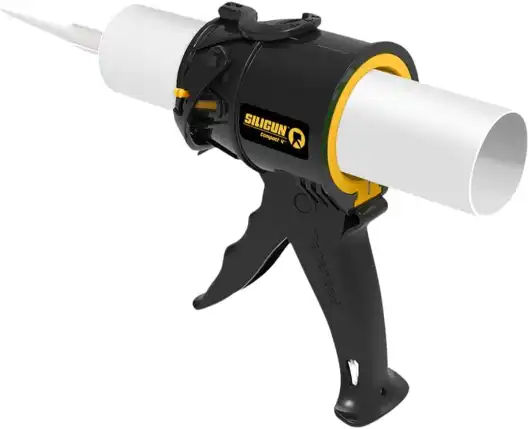
SILIGUN™ Gen-3 Compact Caulking Gun
Check on AmazonKey Specs:
- Push Ratio: 12:1
- Material: Lightweight ABS plastic
- Works with: 10 oz tubes and 310 ml sausage packs
- Design: No push rod sticking out for easy storage
- Upgraded Features: New hook design, better grip tape, improved spring mechanism
The SILIGUN™ Gen-3 Compact Caulking Gun is a game-changer for any sealing job. Its no-drip design ensures precise, clean bead application every time. I love how it’s built for easy storage with no push rod sticking out, which makes it perfect for tight spaces. The lightweight ABS frame is durable and comfortable to hold, even for extended use. The upgraded spring mechanism and better grip tape make it even more reliable for all tube types, from latex to silicone.
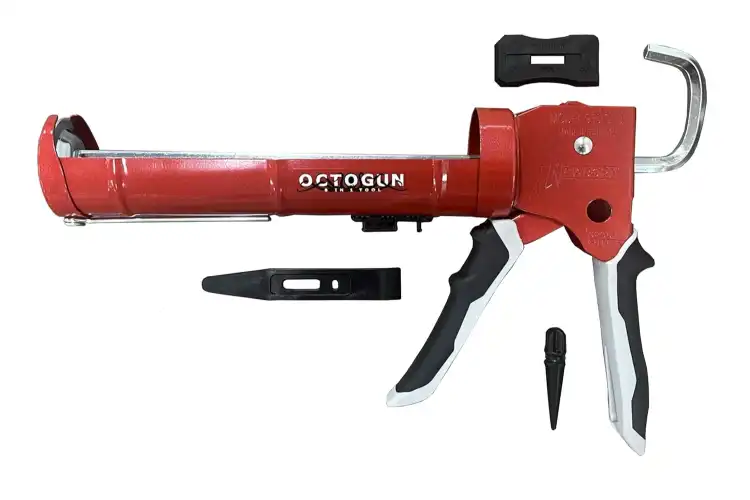
Newborn Octogun 930-GTD Drip-Free Caulking Gun
Check on AmazonKey Specs:
- Thrust Ratio: 10:1
- Compatible with: 1/10 gallon cartridges
- Built-in tools: Scraper, spout cutter, seal puncture tool
- Hex rod: Provides smooth and quiet operation
- Extra features: 4-sided finishing square for a professional bead
The Newborn Octogun 930-GTD is a must-have tool for anyone serious about caulking. The drip-free technology ensures a neat, clean application with no mess. I appreciate the hex rod cradle, which makes caulking much smoother and easier, minimizing fatigue. The added tools, like the spout cutter and seal puncture tool, make starting and finishing projects incredibly efficient. With its 10:1 thrust ratio, the Octogun offers precise control for professional-grade results every time.
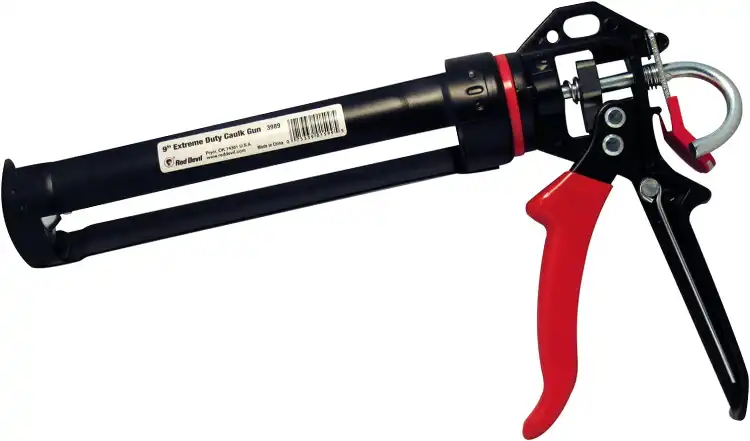
Red Devil 3989 9″ Extreme Duty Caulk Gun
Check on AmazonKey Specs:
- Thrust Ratio: 26:1
- Force: 950 pounds
- Ergonomic Trigger: Comfortable rubber grip
- Revolving Barrel: For maneuverability in tight spaces
- Additional Tools: Seal punch and ladder hook included
The Red Devil 3989 Extreme Duty Caulk Gun is built for heavy-duty use. The 26:1 thrust ratio provides an impressive 950 pounds of force, making it easy to extrude even the thickest materials. I love the revolving barrel, which lets me maneuver easily in tight spaces. The ergonomic rubber trigger ensures comfort during long applications, and the drip-free technology stops material flow instantly. Additionally, the included seal punch and ladder hook add convenience for fast and easy use.
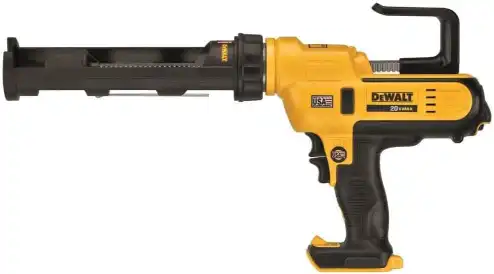
DEWALT 20V MAX Caulking Gun
Check on AmazonKey Specs:
- Speed Control: Variable speed trigger with flow rate dial
- Anti-Drip Feature: Automatically retracts the rod to prevent drips
- Canister Trays: Interchangeable for easy size switching
- LED Light: For low-light visibility
- Storage Hook: Hang hook for convenient storage
The DEWALT 20V MAX Caulking Gun is a game-changer for anyone needing precision and control in their adhesive application. The variable speed trigger gives you fine control over the flow, while the speed dial lets you set your preferred flow rate. I especially appreciate the anti-drip feature, which retracts the plunging rod to prevent messes. The quick-connect interchangeable canister trays make switching between sizes a breeze, and the LED light ensures visibility even in dark spaces.
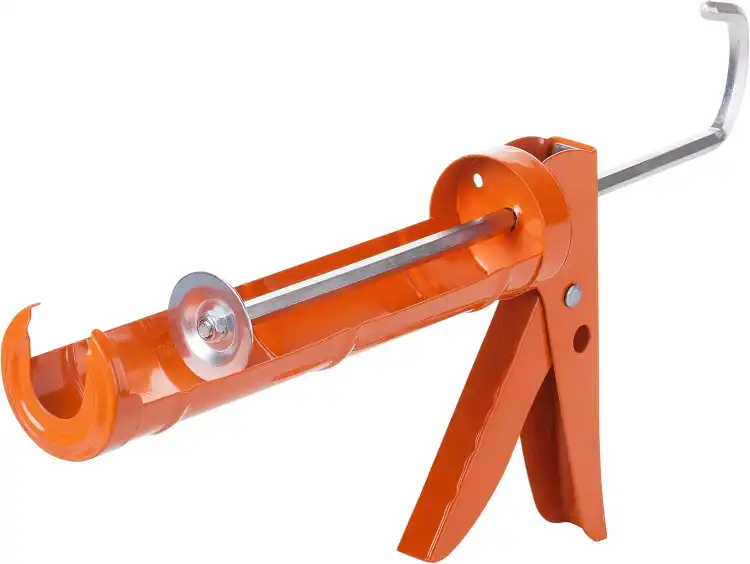
Bates- Caulking Silicone Gun
Check on AmazonKey Specs:
- Thrust Ratio: 10:1 for precise control
- Ergonomic Handle: Comfortable for extended use
- Material Compatibility: Suitable for acrylic, adhesives, asphalt, and more
- Design: Durable and lightweight
- Functionality: No-drip mechanism for clean applications
The Bates Caulking Silicone Gun is the perfect tool for anyone who needs precision and power. The 10:1 thrust ratio ensures smooth, controlled dispensing with minimal effort. It’s built to last, handling everything from acrylic to asphalt with ease. The ergonomic handle reduces hand fatigue during long applications, making it ideal for both professionals and DIY enthusiasts. I find the gun’s no-drip mechanism a real time-saver, ensuring clean, controlled applications with no mess.
Understanding Caulking Guns
A caulking gun is a tool that holds a tube or cartridge filled with material used for sealing gaps and cracks in structures. The gun has a trigger mechanism that when squeezed, forces the material out of the tube and onto the surface where it is needed. The purpose of a caulking gun is to provide a controlled, consistent application of the sealing material.
There are several types of caulking guns available in the market. The most common types include the ratchet rod caulk gun, the smooth rod dripless caulk gun, the electric caulk gun, and the pneumatic caulk gun. Each type has its unique features, advantages, and disadvantages, which we will discuss in detail later in this article.
Understanding the different types of caulking guns can help you choose the right tool for your project. The type of caulking gun you choose can significantly impact the ease of application, the quality of the seal, and the overall success of your project.
Factors to Consider When Buying a Caulking Gun
When buying a caulking gun, it’s important to consider the type of project you’ll be working on. Different projects may require different types of sealants, and some caulking guns are better suited for certain types of sealants than others. For example, if you’re working on a project that requires a thick, heavy-duty sealant, you might want to choose a caulking gun that is designed to handle such materials.
The type of sealant used is another important factor to consider. Some caulking guns are designed to work with specific types of sealants. For instance, some guns work best with silicone sealants, while others are designed for latex or acrylic sealants. Therefore, it’s crucial to choose a caulking gun that is compatible with the type of sealant you plan to use.
The size and durability of the caulking gun are also important considerations. If you’re working on a large project, you might need a larger gun that can hold more sealant. Additionally, you’ll want a durable caulking gun that can withstand heavy use, especially if you plan to use it for multiple projects.
Detailed Analysis of Different Types of Caulking Guns
The ratchet rod caulk gun is one of the most common types of caulking guns. It features a ratchet-style push rod that pushes the sealant out of the tube when the trigger is squeezed. This type of gun is typically less expensive than other types, but it can be harder to control, leading to uneven application of the sealant.
The smooth rod dripless caulk gun, on the other hand, is designed to stop the flow of sealant as soon as the trigger is released. This can help reduce waste and mess, making it a popular choice for many DIY enthusiasts and professionals alike. However, this type of gun can be more expensive than the ratchet rod type.
Electric caulking guns are powered by electricity, either through a cord or a battery. These guns offer a smooth, consistent flow of sealant, making them ideal for large projects or for those who use a caulking gun frequently. However, they are typically the most expensive type of caulking gun.
Finally, pneumatic caulking guns are powered by air pressure. They offer a high level of control and consistency, making them a popular choice for professional contractors. However, they require an air compressor to operate, which can be an additional expense.
Pros and Cons of Different Types of Caulking Guns
The ratchet rod caulk gun is affordable and widely available, making it a popular choice for many. However, it can be difficult to control, leading to uneven application and potential waste of sealant. Additionally, it can be more difficult to stop the flow of sealant once it starts, which can lead to messes.
The smooth rod dripless caulk gun offers a high level of control, reducing waste and mess. However, it is typically more expensive than the ratchet rod type, which may be a consideration for those on a tight budget.
Electric caulking guns offer a smooth, consistent flow of sealant and are ideal for large projects or frequent use. However, they are the most expensive type of caulking gun, and they require access to electricity, which may not always be convenient.
Pneumatic caulking guns offer a high level of control and consistency, but they require an air compressor to operate. This can be an additional expense, and it may not be practical for those who only need a caulking gun for occasional use.
How to Use a Caulking Gun for Seamless Sealant Application
Using a caulking gun properly can ensure a smooth, even application of sealant. The first step is to prepare the tube of sealant. This typically involves cutting off the tip of the tube and puncturing the seal inside. Next, the tube is placed in the caulking gun, with the cut tip pointing out of the front of the gun.
To apply the sealant, the trigger of the caulking gun is squeezed, forcing the sealant out of the tube and onto the surface. The gun is then moved along the surface in a smooth, steady motion, creating a line of sealant. The trigger is released to stop the flow of sealant when finished.
For a seamless sealant application, it’s important to apply the sealant evenly and smoothly. This can be achieved by maintaining a steady pressure on the trigger and moving the gun at a consistent speed. It’s also important to clean up any excess sealant immediately, before it has a chance to dry.
Maintenance and Care for Caulking Guns
Proper maintenance and care can extend the life of your caulking gun and ensure it continues to perform well. After each use, the gun should be cleaned to remove any residual sealant. This can be done using a cloth and a suitable cleaning solution, depending on the type of sealant used.
It’s also important to store the caulking gun properly when not in use. It should be kept in a dry, cool place to prevent rust and other damage. If the gun has a replaceable tube or cartridge, it’s a good idea to remove this before storage to prevent the sealant from drying out and clogging the gun.
Regular inspection of the caulking gun can also help identify any potential issues before they become major problems. Check for any signs of wear or damage, such as cracks in the gun or issues with the trigger mechanism. If any problems are found, it’s best to address them immediately to prevent further damage.
Safety Precautions When Using a Caulking Gun
While caulking guns are generally safe to use, it’s important to take certain precautions to prevent accidents. Always use the gun in a well-ventilated area to avoid inhaling fumes from the sealant. Wear protective clothing, including gloves and eye protection, to prevent contact with the sealant.
Never point the caulking gun at yourself or others, especially when the trigger is being squeezed. Always ensure the gun is pointed away from you and others when loading or unloading the tube of sealant.
In case of an accident, such as contact with the sealant, it’s important to know what to do. Most sealants will cause irritation if they come into contact with the skin or eyes. If this happens, rinse the affected area with water and seek medical attention if necessary.
Conclusion
Choosing the right caulking gun is crucial for a successful sealant application. By understanding the different types of caulking guns and considering factors such as the type of project, the type of sealant used, and the size and durability of the gun, you can choose the right tool for your needs.
Proper use, maintenance, and safety precautions can ensure your caulking gun performs well and lasts for many years. Whether you’re a professional contractor or a DIY enthusiast, a good caulking gun is a valuable tool for any construction or home improvement project.
Remember, a seamless sealant application is not just about the sealant itself, but also about the tool used to apply it. So, invest in a good caulking gun and make your projects look professional and well-done.
FAQ
What is a caulking gun?
A caulking gun is a tool that holds a tube or cartridge filled with material used for sealing gaps and cracks in structures. The gun has a trigger mechanism that when squeezed, forces the material out of the tube and onto the surface where it is needed.
What are the different types of caulking guns?
The most common types of caulking guns include the ratchet rod caulk gun, the smooth rod dripless caulk gun, the electric caulk gun, and the pneumatic caulk gun.
How do I choose the right caulking gun?
When choosing a caulking gun, consider the type of project you’ll be working on, the type of sealant you’ll be using, and the size and durability of the gun.
How do I use a caulking gun?
To use a caulking gun, first prepare the tube of sealant by cutting off the tip and puncturing the seal. Place the tube in the gun, squeeze the trigger to apply the sealant, and move the gun along the surface in a smooth, steady motion.
How do I maintain my caulking gun?
After each use, clean the gun to remove any residual sealant. Store the gun in a dry, cool place and regularly inspect it for signs of wear or damage.
